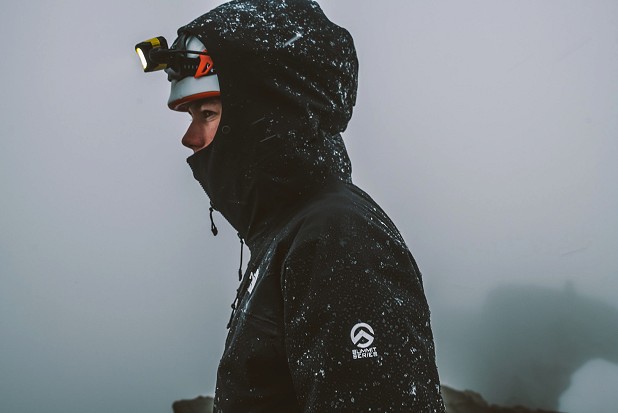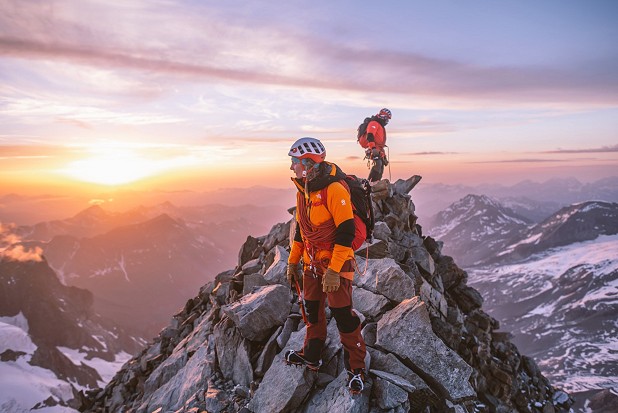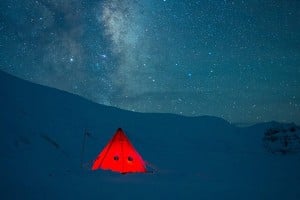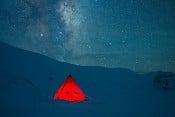
The North Face changed the future of the outerwear industry with the unveiling of FUTURELIGHT™ jackets, pants, and bibs in its Summit Series™, Steep Series™ and Flight Series™ collections. Developed using innovative nanospinning technology, FUTURELIGHT™ will offer first of its kind breathable, waterproof protection.
The concept for FUTURELIGHT™ was born in the mountains out of specific requests from The North Face global athlete team looking for increased performance and breathability in their waterproof gear. Determined to reset the expectation that waterproof product is uncomfortable, heavy and stuffy, The North Face commenced a multi-year journey to create a waterproof fabric that's not only soft, light, flexible and comfortable – but also durable and sustainably designed. After three years of research, product development and extensive lab and field testing, The North Face is proud to introduce the first apparel made from the brand's proprietary, FUTURELIGHT™ fabric.
"Product innovation, pushing the boundaries and having the courage to disrupt have been a part of The North Face DNA since our company was founded over 50 years ago," Scott Mellin, Global General Manager of Mountain Sports at The North Face said. "For far too long, we have been forced to adapt to our clothing and environment. With the introduction of FUTURELIGHT™, we are finally offering clothing that adapts to our needs. The introduction of this fabric is a pivotal moment for our brand, for the future of the apparel industry, and for consumers who will no longer need to sacrifice comfort or air permeability for waterproof protection."
Wear the Future
The nanospinning process used to create FUTURELIGHT™ fabric has allowed the brand to add unmatched air permeability into the membrane of a fabric for the first time. The process creates nano-level holes, allowing for incredible porosity while maintaining total waterproofness, letting air move through the material and provide more venting than ever before.
Nanospinning also gives The North Face designers the ability to adjust weight, stretch, breathability, durability, construction (knit or woven), and texture during the manufacturing process to match both athletes' and consumers' end-use, activity or environment. Designers can customize the fabric for specific usage, for example, by increasing breathability in garments for aerobic pursuits or increasing protection for harsh, wet climates. The ability to adjust these factors in fabric construction and manufacturing is pushing the limits of innovation in apparel, equipment and accessories.
"We are starting with jackets and outdoor apparel, but we won't stop there," Mellin said. "FUTURELIGHT can theoretically make anything breathable, waterproof and for the first time - comfortable. This technology is paving the way for the future of technical fabrics and provides endless possibilities across The North Face product categories."
With the launch of FUTURELIGHT™, The North Face is also aiming to deliver industry-leading sustainability practices through its new fabric creation process. These advances have allowed the brand to responsiblycreate three-layer garments with face and backer layers made up of 90 percent recycled materials.
Athlete Tested, Expedition Proven
FUTURELIGHT has been tested extensively for more than 400 continuous days by 15 members of the brand's global athlete team, proven through use in the highest peaks and harshest environments, including the Himalayas' Lhotse and Everest, in temperatures ranging from -50 degrees F to 60 degrees F.
While testing FUTURELIGHT™ The North Face team alpinist, Jim Morrison climbed, and skied three 8000 Meter peaks 2018, including Everest, Cho Oyu and the world's first descent of Lhotse Couilor with his partner Hilaree Nelson.
"During the past two years, our world class team of climbers, skiers, alpinists, snowboarders and trail runners has been rigorously testing FUTURELIGHT across every discipline to prove this technology in varying weather conditions and climates all over the world," Nelson, The North Face athlete team captain, said. "In all my years in the mountains, I've never experienced a product that moved and performed as well as FUTURELIGHT. It is creating a new paradigm for what I expect out of a waterproof material."
Beyond The North Face athletes and internal testing labs, the brand worked with third-party independent experts including UL, a world-renowned safety science organization, to push the limit of the FUTURELIGHT fabric. UL tests waterproofing for the National Fire Protection Association (NFPA), an organization that certifies first responder gear for firefighters, EMS and hazmat responders.







Comments
It's pretty cool that they've put together a membrane that's 90% recycled, and potentially better performing. We all know it's going to cost more than a house in the highlands though.
Ellis Brigham have them in their new winter catalogue and they are about a ton or two more than the goretex equivalents (Arc'teryx excepted) though that's possibly not surprising.
They are heavy though: the Point Five is quoted as 660g which is old school heavy in my book.
That said, I'd love to try one if the magic money fairy came visiting.
Well, as I understand it (from my limited outsider view), there is nothing really that much new about the nano-spinning process (even the "old" Neoshell was probably some variant of it), plenty of research and applications already, I guess the "secret" is in the engineering for large predictable outputs, making the membrane properly hydrophobic and making the hydrophobicity last (which is the main thing keeping "WPB" garments waterproof but breathable, despite most PR nonsense about "size of pores smaller than water droplets") and adjusting the technique to different fabrics.
Still, I am glad they are pushing it (even if at high prices), as it might mean in the long run:
1) more breathable membranes without PFCs
2) hopefully some more affordable ones from cheaper brands with good enough performance by similar process - since it's hardly plausible they hold the patents on the whole of it
Until then, I would have to pass, as the "magic money fairy" seems to have lost my address...